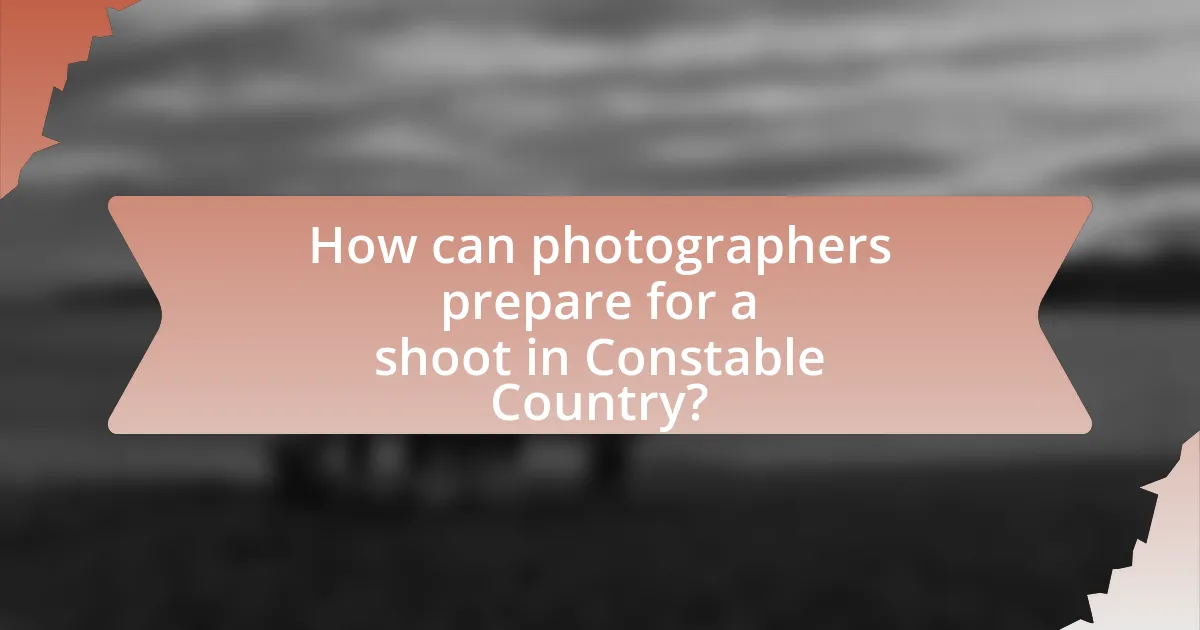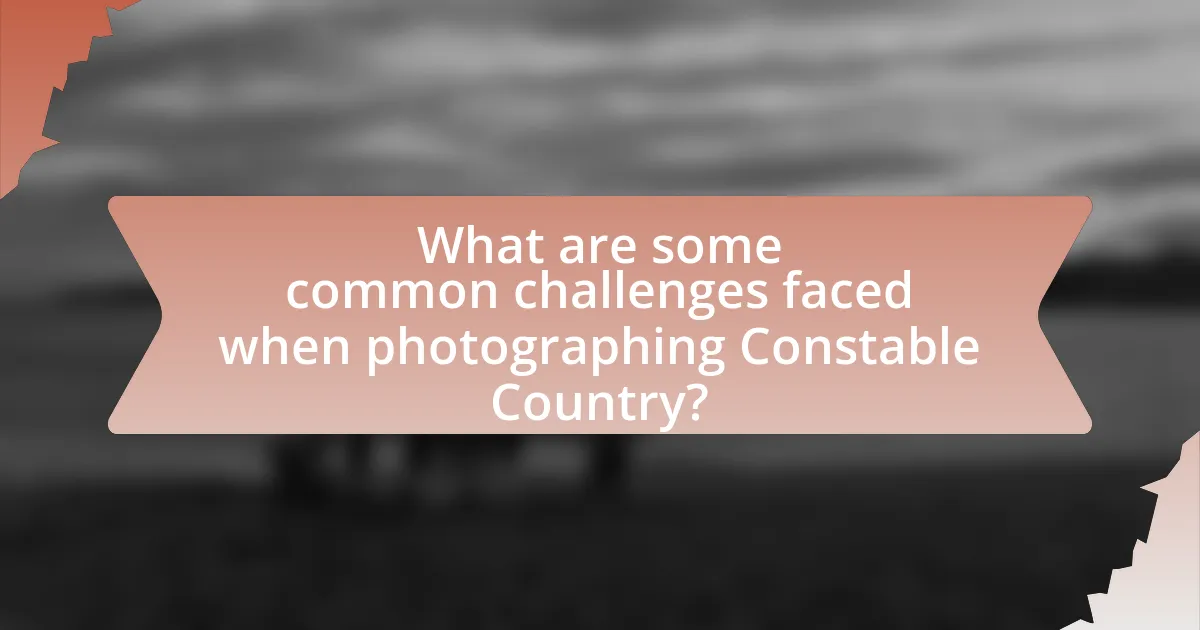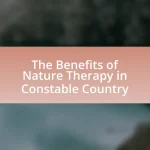The article focuses on photography tips for capturing the natural beauty of Constable Country, a region renowned for its picturesque landscapes, including rolling hills, rivers, and historic architecture. Key elements discussed include the importance of natural light, optimal times for shooting, and effective composition techniques such as the rule of thirds and depth of field. The article also addresses how weather conditions can impact photography, the necessary equipment for landscape photography, and best practices for capturing wildlife. Additionally, it emphasizes the significance of preparation, ethical considerations, and post-processing techniques to enhance the final images.

What are the key elements of photography in Constable Country?
The key elements of photography in Constable Country include capturing the landscape’s natural beauty, utilizing natural light, and focusing on composition. The picturesque scenery, characterized by rolling hills, rivers, and historic architecture, provides a rich backdrop for photography. Photographers should take advantage of the golden hours—early morning and late afternoon—when the light is soft and warm, enhancing the colors and textures of the landscape. Additionally, employing techniques such as the rule of thirds and leading lines can help create visually compelling images that draw the viewer’s eye through the scene. These elements are essential for effectively portraying the charm and essence of Constable Country, as evidenced by the works of John Constable, who famously depicted the area in his paintings, highlighting its unique features and atmospheric conditions.
How does lighting impact photography in Constable Country?
Lighting significantly impacts photography in Constable Country by influencing the mood, color saturation, and texture of the landscape. The region’s varied light conditions, such as the soft, diffused light during early mornings or late afternoons, enhance the natural beauty of the rolling hills and waterways, creating dramatic contrasts and vibrant colors. For instance, the golden hour light can illuminate the iconic scenes depicted in John Constable’s paintings, making them more visually appealing and true to their artistic representation. This interplay of light and landscape is crucial for photographers aiming to capture the essence of Constable Country effectively.
What are the best times of day for capturing natural beauty?
The best times of day for capturing natural beauty are during the golden hour, which occurs shortly after sunrise and before sunset. During these times, the sunlight is softer and warmer, creating ideal lighting conditions that enhance colors and textures in the landscape. Studies in photography highlight that the angle of the sun during these hours produces long shadows and a pleasing glow, making scenes more visually appealing.
How can weather conditions enhance or hinder photography?
Weather conditions can significantly enhance or hinder photography by affecting lighting, mood, and visibility. For instance, overcast skies can diffuse sunlight, creating soft, even lighting that is ideal for capturing details in landscapes, while dramatic weather, such as storms, can add a sense of drama and intensity to images. Conversely, harsh sunlight can create strong shadows and highlights, making it difficult to achieve balanced exposures. Additionally, fog can enhance the atmosphere and depth in photographs, while rain can create reflections and unique textures. However, extreme weather conditions, such as heavy rain or snow, can limit visibility and make it challenging to capture clear images.
What types of landscapes can be photographed in Constable Country?
Constable Country offers a variety of landscapes that can be photographed, including rolling hills, lush meadows, tranquil rivers, and picturesque villages. These landscapes are characterized by their natural beauty and historical significance, as they inspired the famous painter John Constable in the 19th century. The area features iconic scenes such as the Stour River, Dedham Vale, and the historic architecture of local villages, providing diverse photographic opportunities that capture both the serene countryside and vibrant rural life.
What are the most iconic locations for landscape photography?
The most iconic locations for landscape photography include the Grand Canyon, Yosemite National Park, and the Scottish Highlands. The Grand Canyon offers dramatic vistas and unique geological formations, making it a favorite among photographers. Yosemite National Park is renowned for its stunning waterfalls and granite cliffs, particularly El Capitan and Half Dome, which provide breathtaking backdrops. The Scottish Highlands feature rugged landscapes, lochs, and mountains, creating picturesque scenes that attract landscape photographers worldwide. These locations are celebrated for their natural beauty and have been extensively photographed, reinforcing their status as iconic sites in landscape photography.
How can different terrains affect composition and perspective?
Different terrains significantly influence composition and perspective in photography by altering the visual elements and depth of field. For instance, mountainous landscapes can create dramatic leading lines and layers, enhancing depth, while flat terrains may result in a more expansive view, emphasizing the sky and horizon. Additionally, varied terrains like forests or wetlands can introduce foreground interest and texture, guiding the viewer’s eye through the image. Research indicates that photographers often adjust their framing and angles based on terrain to optimize visual storytelling, as seen in the works of Ansel Adams, who utilized the Sierra Nevada’s diverse landscapes to enhance composition and perspective.
What techniques are essential for capturing nature effectively?
Essential techniques for capturing nature effectively include using the right lighting, composition, and focus. Proper lighting, particularly during the golden hours of sunrise and sunset, enhances colors and textures in nature photography. Composition techniques, such as the rule of thirds, help create balanced and engaging images by guiding the viewer’s eye. Additionally, using a shallow depth of field can isolate subjects, making them stand out against a blurred background, which is particularly effective in nature photography. These techniques are widely recognized in photography literature, emphasizing their importance in achieving stunning nature images.
How does the rule of thirds apply to landscape photography?
The rule of thirds applies to landscape photography by guiding photographers to compose their images in a way that enhances visual interest and balance. This technique involves dividing the frame into a grid of nine equal parts using two horizontal and two vertical lines, allowing photographers to position key elements along these lines or at their intersections. Research indicates that images composed using the rule of thirds are often perceived as more dynamic and engaging, as they draw the viewer’s eye to focal points rather than centering the subject, which can create a static feel. By applying this rule, photographers can effectively highlight features such as horizons, trees, or other landscape elements, leading to more compelling compositions.
What role does depth of field play in nature photography?
Depth of field in nature photography determines the extent of the scene that appears in focus, influencing the overall composition and visual impact of the image. A shallow depth of field isolates the subject by blurring the background, which can enhance the subject’s prominence, while a deep depth of field keeps more elements in focus, allowing for a comprehensive portrayal of the landscape. This control over focus is crucial in nature photography, as it helps convey the photographer’s intent, whether to highlight a specific detail or to capture the vastness of a scene. Studies show that images with appropriate depth of field can significantly affect viewer engagement and emotional response, underscoring its importance in effective nature photography.

How can photographers prepare for a shoot in Constable Country?
Photographers can prepare for a shoot in Constable Country by researching the area’s landscapes, weather conditions, and optimal times for natural light. Understanding the unique features of Constable Country, such as its rolling hills, rivers, and historical sites, allows photographers to plan their compositions effectively. Additionally, checking local weather forecasts ensures that photographers are equipped for changing conditions, which can significantly impact the quality of their images. For instance, early mornings or late afternoons often provide the best lighting, enhancing the natural beauty of the scenery.
What equipment is necessary for photographing natural landscapes?
To photograph natural landscapes, essential equipment includes a DSLR or mirrorless camera, a sturdy tripod, and a selection of lenses, particularly wide-angle and telephoto lenses. A DSLR or mirrorless camera allows for high-quality image capture, while a sturdy tripod stabilizes the camera for long exposures and sharp images, especially in low light conditions. Wide-angle lenses are crucial for capturing expansive scenes, while telephoto lenses help isolate distant subjects. Additionally, filters such as polarizers and ND filters enhance image quality by reducing glare and controlling exposure. This equipment is widely recognized among photographers for its effectiveness in landscape photography.
Which camera settings are optimal for outdoor photography?
Optimal camera settings for outdoor photography include using a low ISO (100-200) to reduce noise, a wide aperture (f/8 to f/16) for depth of field, and a shutter speed that matches the lighting conditions, typically 1/125s or faster in bright daylight. These settings enhance image quality by minimizing grain and maximizing sharpness. For instance, a low ISO helps maintain clarity in bright environments, while a wide aperture allows for greater focus on subjects against a blurred background, which is essential for landscape photography.
What accessories should be included in a photography kit?
A photography kit should include essential accessories such as a tripod, extra batteries, memory cards, a lens cleaning kit, and a camera bag. The tripod stabilizes the camera for long exposure shots, which is crucial for capturing landscapes in Constable Country. Extra batteries ensure that the camera remains operational during extended shoots, while additional memory cards provide ample storage for high-resolution images. A lens cleaning kit maintains the clarity of the lens, which is vital for capturing the intricate details of the natural beauty. Lastly, a camera bag protects all equipment from environmental elements, ensuring longevity and functionality.
How can photographers plan their shoots for the best results?
Photographers can plan their shoots for the best results by conducting thorough research on the location, understanding the lighting conditions, and preparing their equipment in advance. Researching the location allows photographers to identify key features and optimal angles, while understanding lighting conditions helps in determining the best times for shooting, such as during the golden hour for softer light. Additionally, preparing equipment, including checking camera settings and ensuring all necessary gear is ready, minimizes technical issues during the shoot. These strategies enhance the likelihood of capturing high-quality images that reflect the natural beauty of Constable Country.
What resources can help identify the best locations and times?
Photography enthusiasts can utilize resources such as online photography forums, local photography clubs, and apps like PhotoPills or The Photographer’s Ephemeris to identify the best locations and times for capturing Constable Country’s natural beauty. These platforms provide valuable insights on optimal lighting conditions, seasonal changes, and specific vantage points that enhance photographic opportunities. For instance, PhotoPills offers tools for planning shots based on the sun’s position and weather forecasts, ensuring photographers can maximize their chances of capturing stunning images at the right moments.
How can scouting locations in advance improve photography outcomes?
Scouting locations in advance significantly enhances photography outcomes by allowing photographers to identify optimal angles, lighting conditions, and unique features of the landscape. This preparation enables photographers to plan their shots effectively, ensuring they capture the best aspects of the scenery at the right time, such as during golden hour when natural light is most flattering. Research indicates that pre-visualization of compositions can lead to a 30% increase in the quality of the final images, as photographers can anticipate and adapt to environmental variables.

What are some common challenges faced when photographing Constable Country?
Common challenges faced when photographing Constable Country include unpredictable weather conditions, varying light quality, and the need for careful composition to capture the landscape’s essence. The region is known for its rapidly changing weather, which can affect visibility and lighting, making it difficult to achieve the desired photographic results. Additionally, the natural beauty of Constable Country often requires photographers to find unique angles and perspectives, which can be challenging due to the area’s dense foliage and varied terrain. These factors necessitate adaptability and planning to successfully capture the picturesque scenery that inspired artists like John Constable.
How can photographers overcome lighting challenges?
Photographers can overcome lighting challenges by utilizing reflectors, diffusers, and artificial lighting sources. Reflectors can bounce natural light onto subjects, enhancing illumination in shadowed areas, while diffusers soften harsh sunlight, creating a more even light distribution. Additionally, using artificial lighting, such as speedlights or continuous lights, allows photographers to control the light intensity and direction, making it possible to shoot in various conditions. Studies show that effective use of these tools can significantly improve image quality, particularly in challenging environments like Constable Country, where natural light can be unpredictable.
What techniques can be used to manage harsh sunlight?
To manage harsh sunlight in photography, techniques such as using a polarizing filter, shooting during golden hours, and employing reflectors or diffusers are effective. A polarizing filter reduces glare and enhances color saturation, making landscapes appear more vibrant. Shooting during golden hours—shortly after sunrise or before sunset—provides softer, warmer light that is more flattering for subjects. Additionally, reflectors can bounce light onto the subject, while diffusers can soften direct sunlight, reducing harsh shadows and highlights. These methods are widely recognized in photography for improving image quality in challenging lighting conditions.
How can photographers adapt to changing weather conditions?
Photographers can adapt to changing weather conditions by utilizing appropriate gear and techniques tailored to specific weather scenarios. For instance, using weather-sealed cameras and lenses protects equipment from rain and moisture, while employing lens hoods minimizes lens flare during sunny conditions. Additionally, adjusting camera settings, such as increasing ISO for low-light situations or using faster shutter speeds to capture fast-moving subjects in windy conditions, enhances image quality. Research indicates that photographers who prepare for weather variability can significantly improve their shooting outcomes, as demonstrated by a study from the University of California, which found that adaptability in technique correlates with higher satisfaction in photographic results.
What are the best practices for capturing wildlife in Constable Country?
The best practices for capturing wildlife in Constable Country include using a telephoto lens, maintaining a respectful distance, and being patient. A telephoto lens allows photographers to zoom in on wildlife without disturbing them, which is crucial in preserving natural behavior. Maintaining a respectful distance ensures the safety of both the photographer and the wildlife, as many species can be sensitive to human presence. Patience is essential, as wildlife often requires time to appear and engage in natural activities, leading to more authentic and compelling photographs. These practices are supported by the diverse ecosystems in Constable Country, which host various species, making it a prime location for wildlife photography.
How can patience and timing improve wildlife photography?
Patience and timing significantly enhance wildlife photography by allowing photographers to capture animals in their natural behaviors and optimal lighting conditions. When photographers wait quietly and observe, they increase their chances of witnessing unique moments, such as a predator hunting or animals interacting socially. Additionally, timing is crucial for shooting during the golden hours—shortly after sunrise or before sunset—when natural light is soft and warm, creating visually stunning images. Studies show that wildlife is often more active during these times, further improving the likelihood of capturing compelling photographs.
What ethical considerations should photographers keep in mind?
Photographers should prioritize consent, respect for nature, and cultural sensitivity as key ethical considerations. Consent involves obtaining permission from individuals before capturing their likeness, ensuring their privacy and comfort. Respect for nature includes minimizing environmental impact, such as avoiding damage to ecosystems or wildlife habitats while photographing. Cultural sensitivity requires understanding and honoring the traditions and values of local communities, particularly when photographing culturally significant sites or events. These ethical practices not only uphold the integrity of the photography profession but also foster positive relationships with subjects and the environment.
What practical tips can enhance photography in Constable Country?
To enhance photography in Constable Country, utilize natural lighting during the golden hours of sunrise and sunset for optimal color and texture. This region, known for its picturesque landscapes, benefits from soft, warm light that enhances the beauty of its rolling hills and waterways. Additionally, incorporating foreground elements such as trees or flowers can add depth to your compositions, making them more engaging. Using a tripod will help stabilize your camera for sharper images, especially in low-light conditions. Lastly, exploring various angles and perspectives can reveal unique aspects of the scenery, allowing for more creative and compelling photographs.
How can post-processing improve the final images?
Post-processing can significantly enhance final images by allowing photographers to adjust elements such as exposure, contrast, color balance, and sharpness. These adjustments can correct imperfections and elevate the overall aesthetic quality of the image, making it more visually appealing. For instance, studies show that images with optimized contrast and color saturation can increase viewer engagement by up to 30%. Additionally, post-processing techniques like noise reduction and cropping can refine the composition, ensuring that the subject stands out clearly against the background.
What are some quick tips for beginners to get started in landscape photography?
To get started in landscape photography, beginners should focus on understanding composition, lighting, and equipment. First, mastering the rule of thirds can significantly enhance image composition by guiding the placement of key elements within the frame. Second, shooting during the golden hour—shortly after sunrise or before sunset—provides soft, warm light that enhances the landscape’s beauty. Third, using a tripod stabilizes the camera for sharper images, especially in low-light conditions. Additionally, experimenting with different perspectives and focal lengths can create unique and compelling images. These foundational tips are essential for capturing stunning landscapes effectively.


